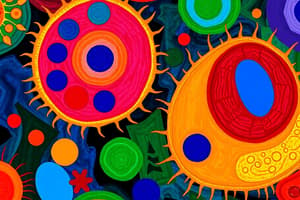Podcast
Questions and Answers
What is the characteristic of unicellular organisms?
What is the characteristic of unicellular organisms?
- They have multiple cells that work together
- They are the largest organisms on Earth
- All biological functions take place in a single cell (correct)
- They are made up of billions of cells
What is the purpose of a microscope?
What is the purpose of a microscope?
- To see the smallest organisms that cannot be seen with the naked eye (correct)
- To study the structure of large organisms
- To study the behavior of unicellular organisms
- To study the function of multicellular organisms
What do scientists use to examine life more closely?
What do scientists use to examine life more closely?
- Magnifying glass
- Microscope (correct)
- Binoculars
- Telescope
How many cells are in the human body?
How many cells are in the human body?
What is the common feature of all organisms?
What is the common feature of all organisms?
What is the difference between unicellular and multicellular organisms?
What is the difference between unicellular and multicellular organisms?
What can be observed when looking at different cells with a microscope?
What can be observed when looking at different cells with a microscope?
What is the role of cells in the living world?
What is the role of cells in the living world?
Why do different cells in a multicellular organism have different shapes?
Why do different cells in a multicellular organism have different shapes?
What is the relationship between cells in a multicellular organism?
What is the relationship between cells in a multicellular organism?
What is the origin of the 37 trillion cells in an adult human?
What is the origin of the 37 trillion cells in an adult human?
What is the process by which a single cell, the zygote, develops into a multicellular organism?
What is the process by which a single cell, the zygote, develops into a multicellular organism?
Flashcards
Unicellular organism characteristic
Unicellular organism characteristic
All biological functions happen within a single cell.
Microscope purpose
Microscope purpose
To magnify tiny organisms for viewing.
Scientist's tool for closer life view
Scientist's tool for closer life view
Microscope
Human cells (number)
Human cells (number)
Signup and view all the flashcards
Common feature of all organisms
Common feature of all organisms
Signup and view all the flashcards
Unicellular vs. multicellular
Unicellular vs. multicellular
Signup and view all the flashcards
Cell shape differences?
Cell shape differences?
Signup and view all the flashcards
Cell role in the living world
Cell role in the living world
Signup and view all the flashcards
Multicellular cell shape
Multicellular cell shape
Signup and view all the flashcards
Multicellular organism cells relationship
Multicellular organism cells relationship
Signup and view all the flashcards
37 trillion cells origin
37 trillion cells origin
Signup and view all the flashcards
Zygote to multicellular development
Zygote to multicellular development
Signup and view all the flashcards
Study Notes
Unicellular Organisms
- Comprised of a single cell; all biological functions occur within this single cell.
- Examples include Bacteria (singular: Bacterium) and Protozoa.
- Unicellular organisms represent the simplest form of life.
Multicellular Organisms
- Consist of billions of cells, enabling complexity and specialization.
- Examples include fish, trees, and humans.
- The term "multicellular" differentiates these organisms from unicellular ones.
Discovery of Cells
- Concept of the cell was not understood until relatively recently.
- Microscopes were invented in the sixteenth century, allowing scientists to observe microorganisms not visible to the naked eye.
- Modern microscopy has greatly advanced, revealing new biological mysteries daily.
Cellular Structure
- All organisms, from bacteria to giant blue whales, are composed of cells, which are fundamental to structure and function.
- The human body contains approximately 37 trillion cells.
Cellular Diversity
- Cells exhibit various shapes (oblong, round, rod-shaped, tadpole-like) and can have changeable forms.
- Different types of cells serve specific functions vital for the organism's survival.
- Coordination among various cell types is essential for the healthy functioning of multicellular organisms.
Development of Multicellular Organisms
- Multicellular organisms originate from a single cell, such as the zygote in humans.
- The process of cell division facilitates growth from a single zygote to trillions of specialized cells.
Studying That Suits You
Use AI to generate personalized quizzes and flashcards to suit your learning preferences.




